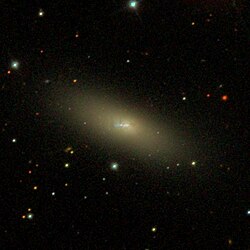Astronomy:NGC 855
| NGC 855 | |
|---|---|
 | |
| Observation data | |
| Constellation | Triangulum[1] |
| Right ascension | 02h 14m 03,5s[1] |
| Declination | 27° 52′ 38″[1] |
| Redshift | 0.001975±0.000017[1] |
| Helio radial velocity | 592 ± 5 km/s[1] |
| Apparent magnitude (V) | 12,6[1] |
| Apparent magnitude (B) | 13,3[1] |
| Other designations | |
| NGC 855 • UGC 1718 • PGC 8557 • CGCG 504-035 • MCG +05-06-016 • IRAS 02111+2738 • KUG 0211+276 • 2MASX J02140361+2752378 • CN 26 613 | |
NGC 855 is a star-forming dwarf elliptical galaxy located in the Triangulum constellation.[2] The discovery and a first description (as H 26 613)[3] was realized by William Herschel on 26th October 1786 and the findings made public through his Catalogue of Nebulae and Clusters of Stars, published the same year.[4]
NGC 855's relative velocity to the cosmic microwave background is 343 ± 18 km/s (343 ± 18) km/s, corresponding to a Hubble distance of 5.06 ± 0.44 Mpc (∼16.5 million ly).[1] There is some uncertainty about its precise distance since two surface brightness fluctuation measurements give a distance of 9.280 ± 0.636 Mpc (∼30.3 million ly), a range outside the Hubble distance determined by the galaxy's redshift survey.[5]
Star formation
Using infrared data collected from two regions in the center of the galaxy by the Spitzer Space Telescope, astronomers were able to suggest NGC 855 to be a star-forming galaxy.[2] Its HI distribution (Neutral atomic hydrogen emission lines) suggests the star-forming activity might have been triggered by a minor merger.[2]
See also
References
- ↑ 1.0 1.1 1.2 1.3 1.4 1.5 1.6 1.7 "By Name | NASA/IPAC Extragalactic Database". http://ned.ipac.caltech.edu/byname?objname=NGC+855&hconst=67.8&omegam=0.308&omegav=0.692&wmap=4&corr_z=1.
- ↑ 2.0 2.1 2.2 Li, Sheng-Peng; Gu, Qiu-Sheng; Zhao, Ying-He; Huang, Jia-Sheng; Luo, Xin-Lian (2007). "A Study of the Star-forming Dwarf Galaxy NGC 855 with Spitzer" (in en). Chinese Journal of Astronomy and Astrophysics 7 (6): 764. doi:10.1088/1009-9271/7/6/03. ISSN 1009-9271. https://dx.doi.org/10.1088/1009-9271/7/6/03.
- ↑ "Catalogue of Nebulae and Clusters of Stars". http://www.messier.seds.org/xtra/similar/h2500b.txt.
- ↑ "Herschel Catalog". http://www.messier.seds.org/xtra/similar/h2500a.html.
- ↑ "NED Query Results for NGC 855". https://ned.ipac.caltech.edu/cgi-bin/nDistance?name=NGC+855.
Coordinates: ![]() 02h 14m 03.5s, −27° 52′ 38″
02h 14m 03.5s, −27° 52′ 38″
External links
- NASA/IPAC Extragalactic Database - Extensive database of NGC objects.
 |

